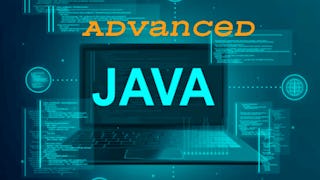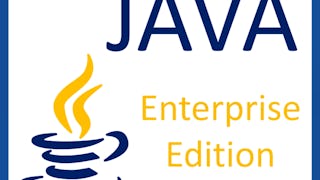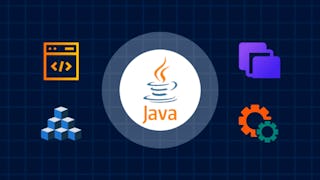This comprehensive course equips learners with the skills to design, develop, and manage dynamic web applications using Java Servlets and JDBC integration within the Java EE framework. Through a structured and hands-on approach, learners begin by exploring the core principles of servlet architecture, HTTP request handling, and server setup using Tomcat. As the course progresses, they will implement servlet lifecycle methods, configure initialization parameters, and construct scalable applications using the MVC pattern.

Discover new skills with 30% off courses from industry experts. Save now.


Java Servlets Tutorial
This course is part of Java Servlet Development: From Basics to Real-World Projects Specialization

Instructor: EDUCBA
Included with 
Recommended experience
Skills you'll gain
Details to know

Add to your LinkedIn profile
July 2025
28 assignments
See how employees at top companies are mastering in-demand skills

Build your subject-matter expertise
- Learn new concepts from industry experts
- Gain a foundational understanding of a subject or tool
- Develop job-relevant skills with hands-on projects
- Earn a shareable career certificate

There are 8 modules in this course
This module introduces the foundational concepts of Java EE (J2EE) and the role of servlets in web applications. Learners will gain a practical understanding of servlet architecture, how to set up the environment using Tomcat, and implement basic servlet functionality through lifecycle methods and HTTP request handling. It builds the core knowledge required to develop and deploy servlet-based applications in a Java EE environment.
What's included
8 videos4 assignments
This module explores the use of servlet configuration and context objects, enabling learners to manage shared application data and initialization parameters. The lessons focus on differentiating between ServletConfig and ServletContext, understanding their practical use cases, and configuring servlet behavior through load-on-startup mechanisms. This sets the stage for building efficient, state-aware web applications.
What's included
5 videos3 assignments
This module introduces the Model-View-Controller (MVC) architectural pattern within the context of Java Servlets. Learners will explore how to separate concerns in web application development, implement request dispatching using RequestDispatcher, and understand how forwarding and redirection operate within servlet-based architectures. Through practical code examples and guided explanation, this module emphasizes clean design and control flow in servlet applications.
What's included
10 videos4 assignments
This module focuses on preserving user data across multiple interactions with a web application. Learners will explore the core techniques of session tracking in Java Servlets, including cookies, hidden fields, and URL rewriting. The lessons provide hands-on exposure to maintaining state in stateless HTTP environments, helping learners build more interactive and user-aware applications.
What's included
7 videos4 assignments
This module extends session tracking by focusing on HTTP session objects and cookie-based authentication mechanisms. Learners will learn how to implement login/logout functionality using both session and cookie strategies. By building end-to-end examples, this module helps consolidate skills in user session control, secure access, and lifecycle handling of web interactions.
What's included
7 videos3 assignments
This module introduces learners to database fundamentals and SQL operations in the context of Java web development. It begins with a foundational overview of relational databases and continues through practical SQL syntax, covering commands for data manipulation, definition, and constraint enforcement. Learners will understand how to prepare data environments for backend integration with servlet-based applications.
What's included
14 videos4 assignments
This module bridges Java web applications with backend databases using JDBC (Java Database Connectivity). Learners will explore how to establish connections, perform CRUD operations, and securely interact with database systems through servlets. The lessons emphasize JDBC classes and interfaces, as well as best practices for real-world data handling.
What's included
6 videos3 assignments
What's included
6 videos3 assignments
Earn a career certificate
Add this credential to your LinkedIn profile, resume, or CV. Share it on social media and in your performance review.
Explore more from Software Development
 Status: Preview
Status: PreviewLearnKartS
 Status: Free Trial
Status: Free TrialLearnQuest
 Status: Free Trial
Status: Free TrialBoard Infinity
 Status: Free Trial
Status: Free Trial
Why people choose Coursera for their career





Open new doors with Coursera Plus
Unlimited access to 10,000+ world-class courses, hands-on projects, and job-ready certificate programs - all included in your subscription
Advance your career with an online degree
Earn a degree from world-class universities - 100% online
Join over 3,400 global companies that choose Coursera for Business
Upskill your employees to excel in the digital economy
Frequently asked questions
To access the course materials, assignments and to earn a Certificate, you will need to purchase the Certificate experience when you enroll in a course. You can try a Free Trial instead, or apply for Financial Aid. The course may offer 'Full Course, No Certificate' instead. This option lets you see all course materials, submit required assessments, and get a final grade. This also means that you will not be able to purchase a Certificate experience.
When you enroll in the course, you get access to all of the courses in the Specialization, and you earn a certificate when you complete the work. Your electronic Certificate will be added to your Accomplishments page - from there, you can print your Certificate or add it to your LinkedIn profile.
If you subscribed, you get a 7-day free trial during which you can cancel at no penalty. After that, we don’t give refunds, but you can cancel your subscription at any time. See our full refund policy.
More questions
Financial aid available,

